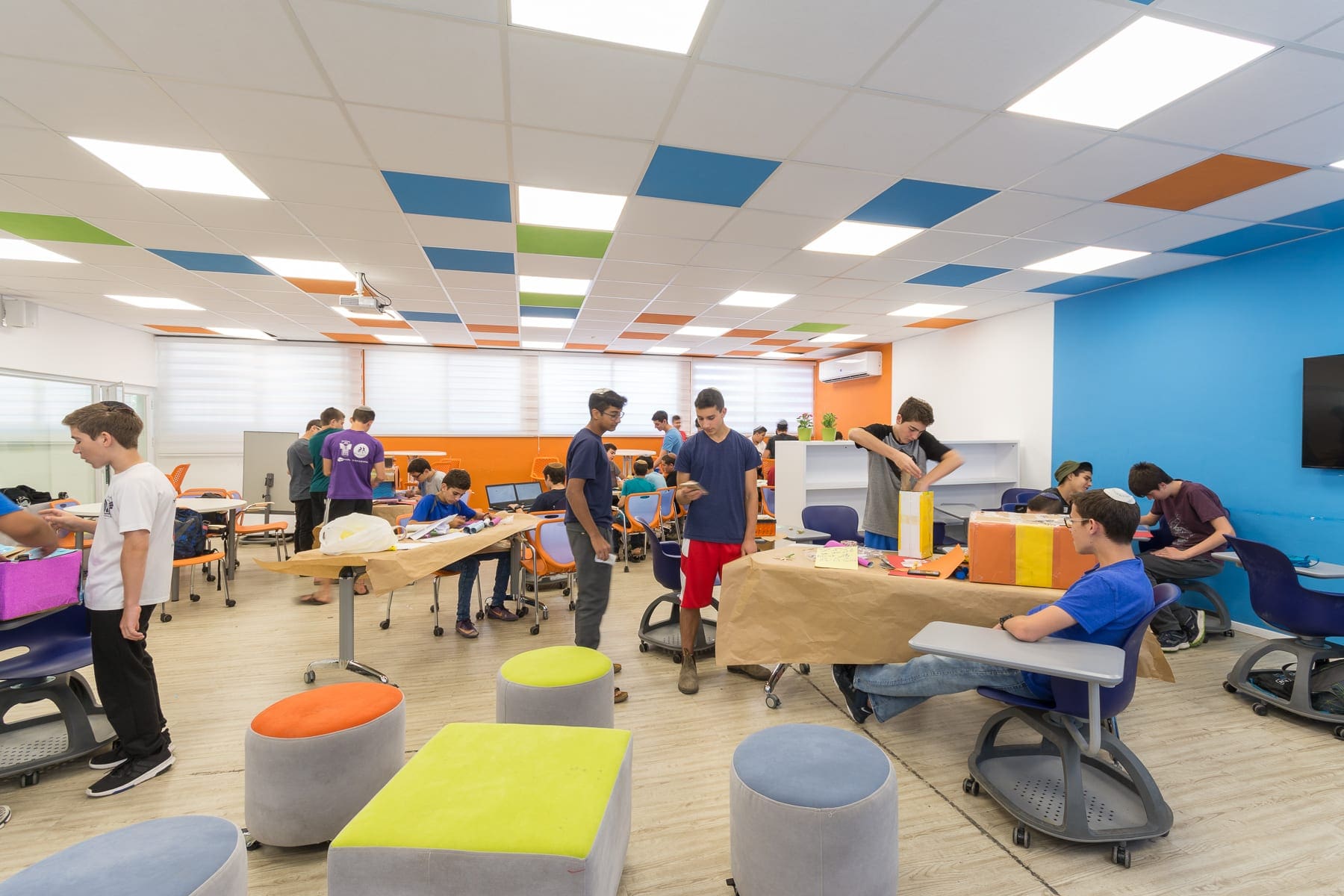This article describes the innovations in use of space and building design of the AMIT religious network of schools in Israel. It is important to emphasize that space-design by itself will not accomplish pedagogic improvement; space-design is at most supportive to innovative pedagogy. Once we define our concept of learning, we can explore how spatial redesign supports and enhances it.
A halakhic model
Regarding the obligation to teach the Exodus to children (and ourselves) at the Passover Seder, Rambam formulates halakhically required spatial and design elements that facilitate pedagogy at the Passover Seder:
One must create change [in design and atmosphere] on this night. The purpose of these changes is to facilitate questioning (and the saying of the “How is this night different” paragraph). How does one implement change? i) nuts and roasted candy are distributed prior to the meal [normally, meal table design does not allow the setting of candy prior to the meal]; ii) the table is taken away before the guests prior to eating [normal table design allows guests to sit without withdrawing the table after seating]; iii) matzah is grabbed one person from another [normal table atmosphere is one of decorum where snatching is not allowed]; iv) and similar activities (Mishneh Torah, Hametz & Matzah 7:4-5).
Rambam emphasizes that this change in design and atmosphere is not an end in itself but a means to facilitate a certain type of pedagogy, inquiry pedagogy. Just telling children to ask would not accomplish as much since children would ask what the adults are expecting them to – the redesign removes inhibitions of caution and encourages genuine fascination and exploration.
21st century students
Children today do not learn the way children in the 20th century did. No one goes to a teacher to find information about the French Revolution; they reach for their iPhone and access many sources of information right out of their pocket. They do not understand why they have to physically sit in a classroom and listen to a teacher lecture when in today’s reality all they need to do is find the material online. As such, for teachers to be relevant, the role of the teacher must no longer be as the source of knowledge, and the change of the teacher’s role must be accompanied by a shift in pedagogy. How students learn becomes a central question.
Students are naturally active and curious, so their learning experience should resonate with that. Schools can be transformed into educational communities with students who are active, together with their teachers, in the learning process. Teachers function as learning facilitators rather than as instructors. Students can prepare lessons, teach fellow students, and learn presentation skills. The individual strengths of students can be enhanced while they receive support for their areas of weakness. Individual learning styles can be accommodated. An innovative educational environment enables students to create for themselves a personal identity grounded in learning, based on values, and a sense of belonging to a community, nation, and state.
Learning in AMIT schools
The above vision of learning was adopted by the AMIT school network. Pedagogical approaches emphasize the Flipped Learning model, in which students learn at home from video clips filmed by the teacher and then devote class time to solving homework-type problems, and Project Based Learning, in which students gain knowledge and skills by working for an extended time period to investigate a problem or issue.
Together, these pedagogies have fostered student creativity: Ninth and tenth grade students design apps with the help of high-tech companies that visit their schools, and students routinely compete in robotic competitions. The products of this pedagogy are not just in technological areas, but are expressed in social projects as well. For example, students organize blood drives and make recommendations to mayors on naming streets after poets.
Space and school design
To take full advantage of the new pedagogical approaches, it became necessary to rethink what the schools looked like. The redesign of the schools was made with the assistance of FNI, the company founded by architect Prakash Nair. This company has worked with dozens of schools on six continents and can accommodate schools with limited budgets. The redesign includes both architectural services (redesign of school buildings) and curriculum services (redesign of curriculum and teaching methods).
The concept of space is embodied in GOGYA, the recently built training institute for AMIT teachers. GOGYA and AMIT schools are ultra-modern, with glass-walled classrooms, an abundance of natural sunlight, creative workrooms, and modular furniture. The buildings have the look and energy of a high-tech startup. Chairs and tables are mobile and modular, facilitating students who want to regroup or pair in havruta. There are several boards in each classroom, encouraging formation of multiple groups. There is a teacher “station” on the side of the room where the teacher serves as a resource, emphasizing the teacher’s role as facilitator rather than instructor.


by Russell Jay Hendel
Russell Jay Hendel teaches Actuarial Mathematics at Towson University. He holds a Doctorate in theoretical mathematics from MIT, an Associateship from the Society of Actuaries, and is currently in a Doctoral program at the Spertus Institute . Dr. Hendel has published extensively and recently co-authored Comprehensive Problem Solving and Skill Development For Next Generation Leaders (IGI, 2017). He is a member of the President’s circle of AMIT.
See all the previous issues of Jewish Educational Leadership
The very notion of a classroom has been replaced by a dynamic model. Learning spaces are typically large, open areas in which multiple groups of up to one hundred students learn simultaneously and are served by a team of four teachers. The “traditional” classrooms which remain have glass walls, further enhancing the open environment. The total feel of the school is one of an ongoing learning community.
Attention is paid to details as small as the color of the walls. Classroom walls are colorful enough to make the students feel alive, but not too colorful as to overwhelm them. The rooms in the GOGYA center feature warm green-gray-orange colored patterned rugs, set off by white and occasional blue walls. There is a shaded open space with a wood parquet floor enabling those students who wish to engage in contemplative study outside.
Pedagogy and school architecture in sync – an example
Students in a class on Talmud prepare on their own – either at home or in a common area in school – using a variety of tools available. They arrive in a circular classroom with their own concepts of how to understand a particular Talmudic sugya (discussion). In the room they form small groups, enabled easily by their swivel chairs and the multiple boards available to record their group’s ideas. Students are free to move amongst the groups, or even to leave the room to continue their discussions in quieter spaces. As students present to the rest of the class the teacher engages them dialogically, noting the similarities between their approaches and those of the Rishonim (primary medieval commentaries). Student engagement is significantly increased as students are empowered to take control of their learning and join a 2000-year old conversation.

Teacher training
Together with a new pedagogical approach and a facility designed to support it, there was a need for training of the faculty to adjust their teaching. Empowering students requires teachers to relinquish their traditional control. Collaboration with other teachers – both within and outside of their disciplines – was going to be essential, and an entirely new vision of assessment needed to be learned.
To facilitate this across a network of schools, each school selects an “R&D team” which meets monthly at the GOGYA center to be exposed to new and innovative learning techniques from educational experts and from each other’s experiences in the classroom. Those teams then return to their schools where they work with their colleagues in introducing and supporting the new pedagogical approaches.




